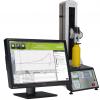

An introduction to peel tests
Peeling tests are the practice of testing adhesion properties of film bonded to substrate, usually by tensile. The peel strength determines the adhesive strength (also called the adhesive fracture toughness). Physical testing of packaging products by peeling can tell us a lot about its properties and manufacturing process such as sealing consistency, bonding strength, adherence ability, cohesive properties of the interface, bond durability and other parameters.
There are two primary reasons for performing a peeling test:
1. Assessing the uniformity of the adhesion of a given type of pressure sensitive adhesive interface, which indicates a bad adhesion between the adhesives and the adherens.
2. Distinguishing between acceptable and unacceptable criteria, by determining the adhesive strength range which is acceptable for consumer or for the purpose of the adhesive.
How does a peeling test perform?
Measurements require a force gauge, suitable grips (capable of clamping the specimens firmly and without slippage throughout the tests) and a motor driven mechanism to pull the product under test at a steady rate and controlled angle.
Clamp the bent and unbonded ends of the test specimen in the test grips. Apply the load. Measure and record the force response. Ideally the force versus displacement curve to initiate and propagate the response should be recorded.
The curve of the load versus distance peeled shows an initial peak and the bond line, example of a peeling test:
VIDEO of a T-peel test by Andilog
Are there different testing protocols?
It is important to note that the adhesive strength varies with peeling angle and knowledge of the phase angles is required to analyze and perform the peel test. Here are some examples of different testing methods:
- Peeled at 180° angle (single coated)
- Peeled at 90° angle to a surface (single coated film)
- T-peel test on flexible bonded specimens
- Floating roller peel test according to ASTM standard D3167
| Peeled at 180° angle | Peeled at 90° | T-peel test on flexible | Floating roller peel |
 |
 |
 |
 |
What are the benefits or efficiencies gained by using a peeling tester?
These tests are tools for quality assurance control and use, the benefit of performing objective, accurate and repeatable peeling testing can improve product consistency and assess interface adhesion.
Example of properties measured: static adhesion, bond durability, compare the interlaminar strength, surface and adhesives screening, manufacturing control of composite bonded parts
Example of products tested: tape, labels, coating, bonded materials, sealed materials
Andilog provides a large product lines to perform peeling tests: (mettre des liens hypertextes vers les pages produits)






